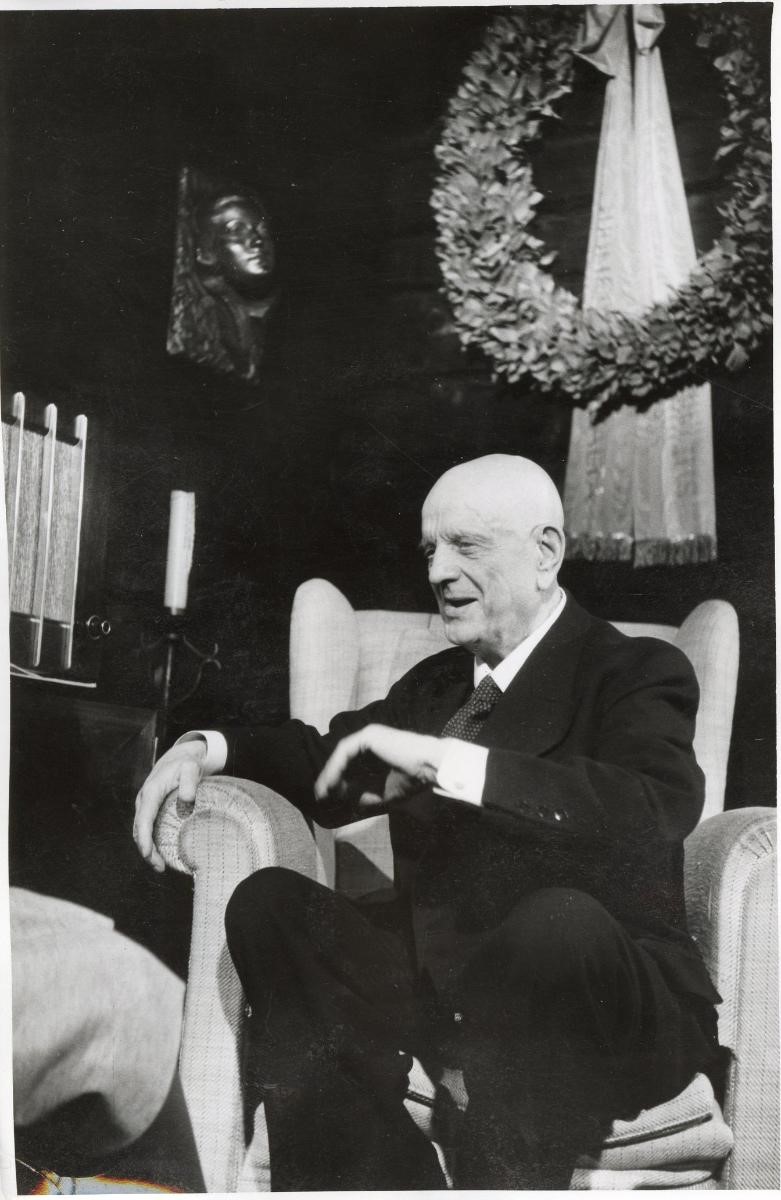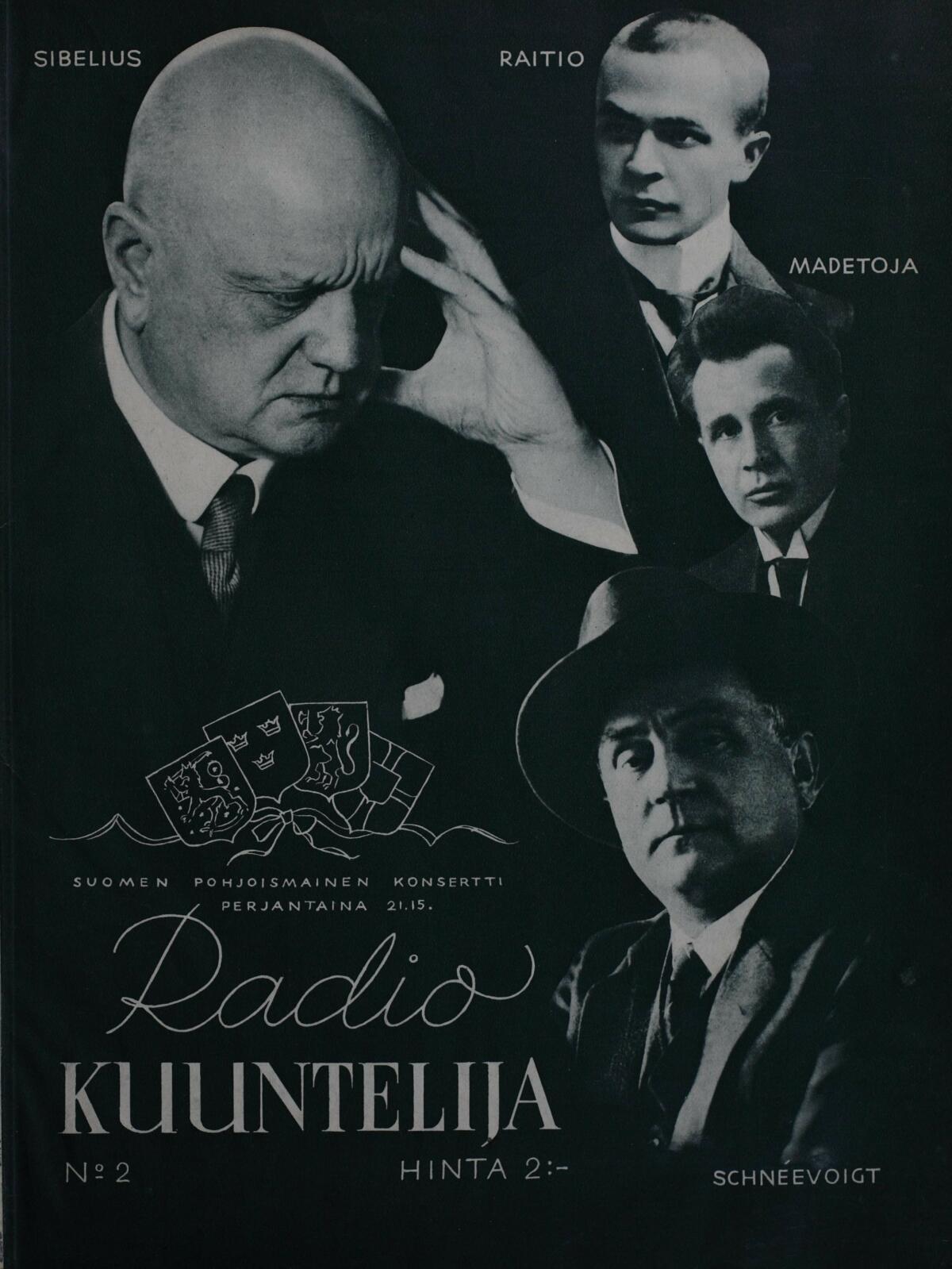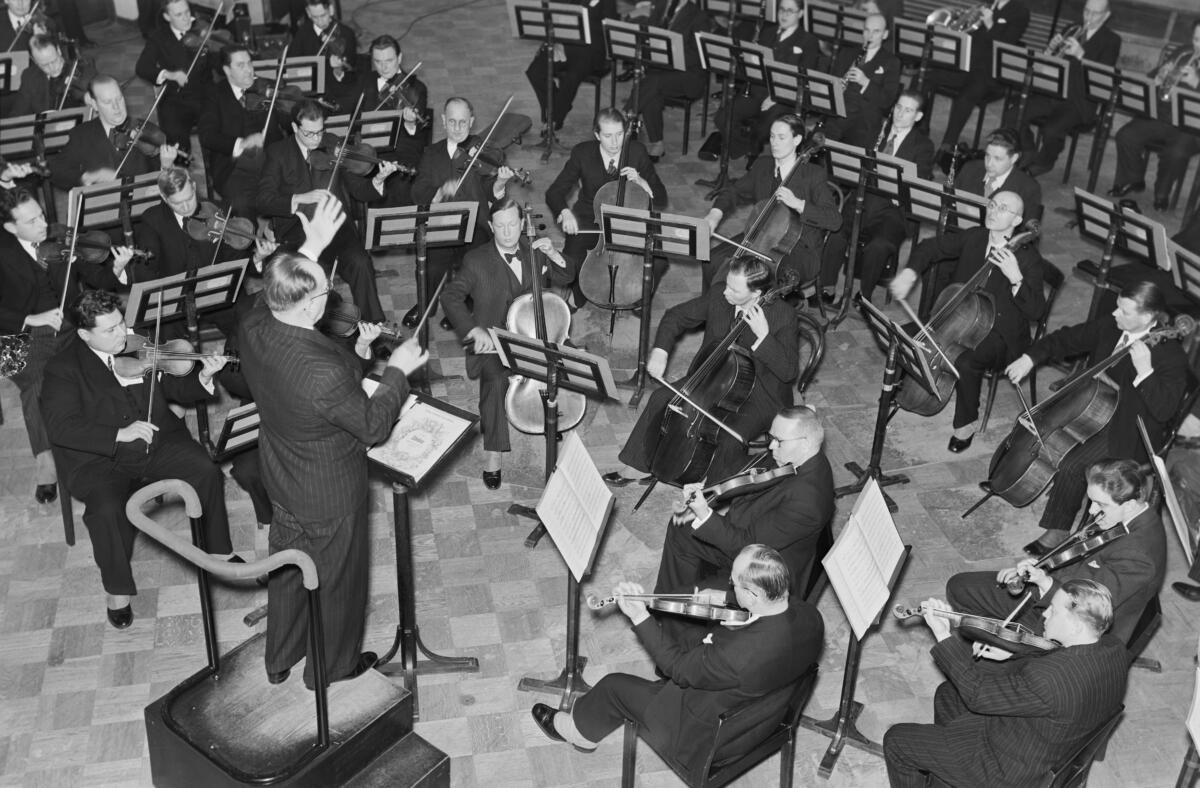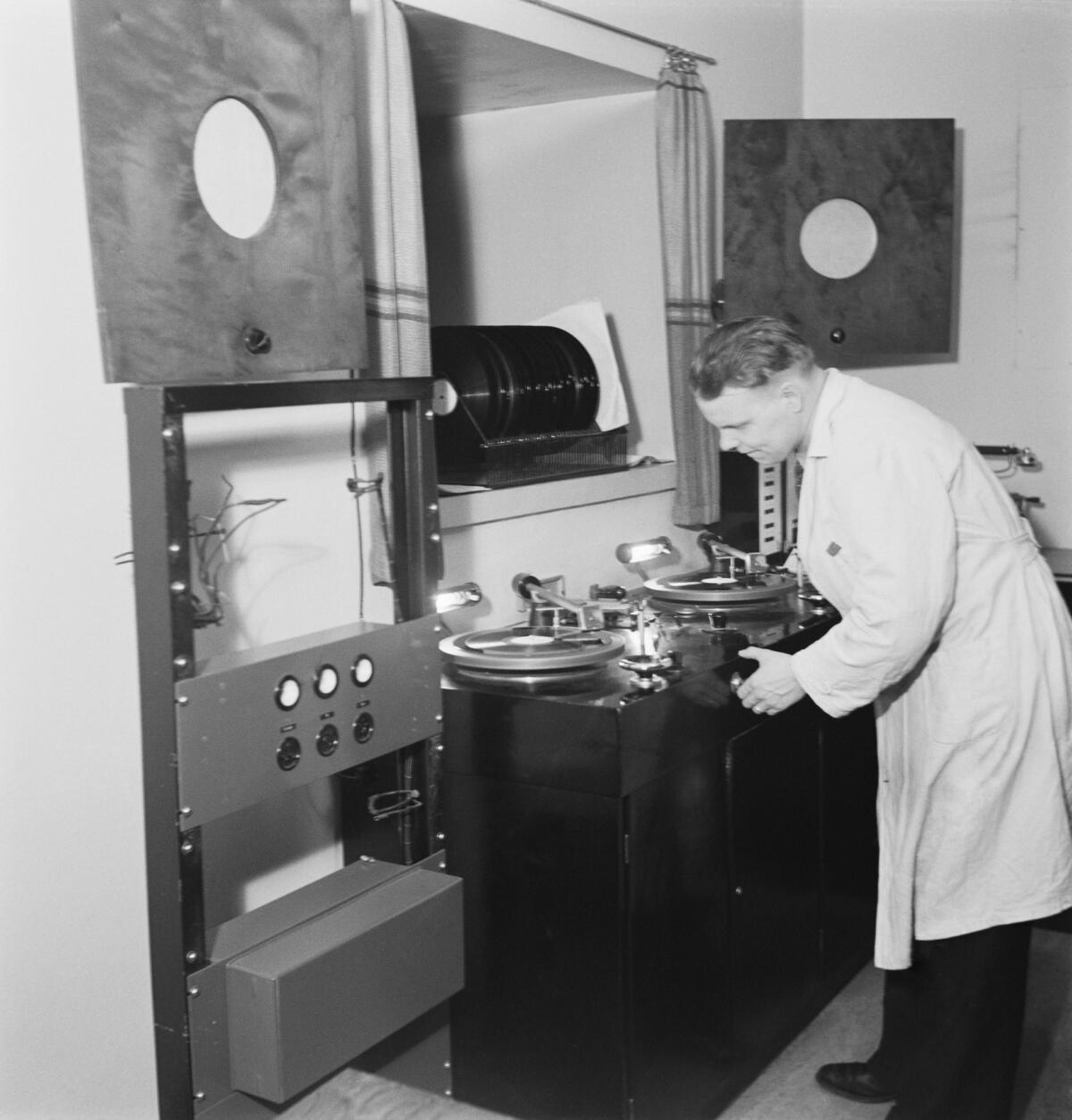Jean Sibelius – Finland’s most famous radio star
Jean Sibelius (1865–1957) was a well-known composer outside Finland already in the early 20th century. In the 1930s, his fame grew into new spheres. At that stage, Sibelius himself had already stopped publishing new masterpieces. According to Janne Mäkelä`s blog post it was radio that catapulted him to global fame.
According to various sources, a typical evening in Järvenpää’s Ainola in the 1930s went as follow: Composer Jean Sibelius goes to the corner of the library, sits in his armchair and turns on the radio. His wife Aino joins the company. The composer lights a cigar and adjusts the radio control. Finally the right station is found. The transmission crackles and hisses as always, but that is not a major problem. From the radio comes music that Jean Sibelius knows better than anyone else in the world.

In Sibelius literature, there is a lot of discussion about “the silence of Ainola”. The phrase has referred to Sibelius’s silence as a composer and his withdrawal from the public eye. The expression is metaphorical, however. Based on biographical information, radio was often listened to in Ainola, and even at high volume. The constant flow of admirers, especially during the summertime, on the other hand, underlined the fact that the composer’s withdrawal from the reach of others was an exaggeration.
However, as composer, Sibelius did remain silent. One of the strange coincidences of history is that Sibelius completed his last major work Tapiola in the late Summer of 1926. A few days later, the Finnish broadcasting company Yleisradio started its radio broadcasts. One monument fell silent, another echoed its first cry. Perhaps so but on the other hand it was not a coincidence that Yleisradio’s first broadcast on September 9, 1926 contained Sibelius’s music (performed by a quartet of Helsinki City Orchestra, the work is unknown). The moment was festive, and what could have been more festive for the beginning of a new era than to perform music by Finland’s most famous composer.
A few years later, Sibelius’s international reputation grew to peak numbers, although the composer himself remained silent and sat at home smoking cigar and listening to the radio. Interestingly, Sibelius mainly listened to his own compositions on the radio. He got information about foreign broadcasts from newspapers and magazines and from telegrams sent by admirers from abroad. Sibelius was probably the most informed radio listener in Finland. He was also Finland’s most famous international radio star.

The Era of AM technology
The first radio broadcasts, both in Finland and elsewhere, were live broadcasts with majority of the programmes being music performances. Gramophone records were played, but rarely. Recording technology entered Yleisradio in the mid-1930s but it was not until the post-war years that the use of pre-recorded programmes became more common. The early radio broadcasts were also international in nature. Thanks to the amplitude modulation technology, the radio signal reached hundreds and even thousands of kilometers away. From Finland, the AM signal was transmitted to the world excellently after the most powerful radio mast in Europe was constructed in Lahti in 1928.
Radio was the most exciting media of the 1930s. It was new, electronic and, above all, transnational music media. The radio signal crossed national borders. European radio companies realised early on that the situation is favourable for coordinated joint broadcasts. The central offering of such broadcasts was non-vocal classical art music that crossed language boundaries more effectively than vocal music. It was also music that most broadcasters thought was the best music available. Finland had a special position in this situation since Yleisradio had a composer to offer who, in the opinion of many, was the greatest and most significant living composer of classical music. When it was Finland’s turn to organize such a joint concert, it could happen that the programme featured nothing but compositions by Jean Sibelius.
Sibelius’s music was also heard in the programmes of radio companies other than Yleisradio, especially in 1935, when the composer turned 70. His birthday was an international media event. In the same year, Yleisradio broadcast live Sibelius concerts to its listeners from, for example, the United States.
Greetings from Helsinki
The relationship between radio and Sibelius was close, but in Finland the composer actively participated in the creation of a radio programme only once (in Copenhagen he had conducted an orchestra in a radio broadcast already in 1924). Sibelius was lured to conduct the Radio Orchestra on New Year’s Day 1939. The concert was a live broadcast to the United States in connection with the New York World Fair. Of course, it was also heard on Yleisradio’s frequency.
The concert that was organized in the Great Hall of the University of Helsinki was a very festive and high-profile event. Only a select audience from the top of the domestic power and cultural hierarchy was allowed into the Hall. Taking pictures of Sibelius was strictly forbidden. Furthermore, efforts were made to keep the radio transmitters and other electronic devices hidden as Sibelius had little experience with their presence in a concert situation. Engineers and other radio professionals still recalled the “microphone freak”, which in the late 1920s had frozen performers who were not used to radio broadcasting equipment, including conductor Robert Kajanus.
Everything went well. The announcer Lauri Miettinen expressed his belief in the significance of the concert as a beacon that illuminates the beginning of a new era and leads nations towards friendship and better international understanding. The speech culminated the Thirties idea that radio, Sibelius and classical art music may act as a unified cultural ambassador of peace on a global level.
The most awaited moment of the hopeful concert came when the extended Radio Orchestra, conducted by Toivo Haapanen, finished the Finnish national hymn Maamme and Jean Sibelius stepped on the conductor’s podium, raised his baton and began to lead the orchestra through his slow-tempo Andante festivo. The performance, later characterized as suggestive, lasted six minutes. The programme included speeches and choral singing, and Sibelius’s Finlandia conducted by Haapanen.


World War II put a temporary stop for the transnational radio broadcasts that gradually faded away in the 1950s as AM radio technology became replaced by more reliable short-range FM technology. Traces of the era can still be heard, however. Sibelius’s live appearance as a radio conductor in 1939 was considered such a significant event that Andante festivo was secretly recorded on a sound record using the direct engraving method. Later, as technology developed, his performance in these instantaneous discs were transferred to magnetic tape and then to digital platforms. In 2006, Andante festivo ended up among the first digitized programmes on Yleisradio’s new Elävä arkisto online service. It is telling that Yleisradio’s music journalists were not interested in the finely restored version of the recording but wanted to use the original lo-fi version that they considered to be authentic crackle of radio history.
Janne Mäkelä
The writer is visiting researcher at the Research Institute of the University of the Arts Helsinki and member of Yle 100 Culture research programme of the University of Turku.
The text is based on the author’s article “Radio ja Sibelius. Rajoja ylittävä mediasuhde vuosina 1926–1957”. Lähikuva 1/2024.
Dynamic interpretations of the past
The Uniarts Helsinki History Forum blog regularly publishes comments on topical themes and initiatives regarding the history of performing arts. The blog posts are written by researchers affiliated with the Uniarts History Forum. In their texts, the researchers shed light on both their own academic projects and the fields of arts and history research in general. The blog “Dynamic interpretations of the past” is a publication (ISSN 2736-9986). Editorial board: Anne Kauppala (editor in chief), Kaarina Kilpiö, Vesa Kurkela, Markus Mantere, Saijaleena Rantanen and Marianne Mieskolainen (editorial coordinator). History Forum is part of Uniarts Helsinki`s Research Institute.
Taideyliopiston Historiafoorumi -tutkimusverkoston blogissa julkaistaan säännöllisesti puheenvuoroja esittävien taiteiden historiantutkimuksen ajankohtaisista aiheista ja aloitteista. Blogikirjoitukset kertovat niin tutkimuskeskuksen tutkijoiden omien hankkeista kuin yleisemminkin historian- ja taiteentutkimuksen kentän ilmiöistä. “Dynamic Interpretations of the Past” -blogi on julkaisu (ISSN 2736-9986). Toimitusneuvosto: Anne Kauppala (päätoimittaja), Kaarina Kilpiö, Vesa Kurkela, Markus Mantere, Saijaleena Rantanen ja Marianne Mieskolainen (toimitussihteeri). Historiafoorumin on osa Taideyliopiston Tutkimusinstituuttia.
I Konstuniversitetets Historieforums blogg publicerar vi regelbundet kommentarer och initiativ om scenkonstens och musikens historia. Våra bloggtexter är skrivna av de forskare som är affilierade vid Konstuniversitetets Historieforum. Texterna belyser såväl forskarnas egna akademiska projekt som forskningsfälten kring historie- och konstforskning i allmänhet. Bloggen “Dynamic interpretations of the past” är en publication (ISSN 2736-9986). Redaktionsråd: Anne Kauppala (ordförande för redaktionsrådet), Kaarina Kilpiö, Vesa Kurkela, Markus Mantere, Saijaleena Rantanen och Marianne Mieskolainen (redaktionssekreterare). Historieforum tillhör av Konsuniversitets Forskningsinstitut.
Latest posts
Follow blog